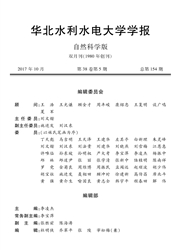

 中文摘要:
中文摘要:
水文变异现象已造成许多地区的水文数据受到“污染”,使得传统水文频率计算举步维艰。同时,水文变异识别方法的异法异解、隐藏效应、自相关性影响、变异信息交叉等问题也困扰着水文变异理论的发展。亟待解决。针对水文变异识别中的序列自相关性影响,提出将去趋势、预置白与ICSS检验法相结合,构建TF-PW—DT—ICSS法,对渭河咸阳水文站的径流数据进行方差变异的多点识别,同时应用水文频率计算方法验证变异点的准确性。结果表明:TFPw—DT—ICSS法通过TFPW处理,可缓解序列自相关性对结果的影响;ICSS算法在方差变异检验上可获得较为准确的识别结果,适用于水文序列的方差变异诊断;ICSS算法对数据长度变化的响应不敏感,可实现多序列上的有效识别。研究成果可为变化环境下的水文计算与设计提供数据支持和技术支撑。
 英文摘要:
英文摘要:
Hydrological variation occurring in many areas has caused the " contamination" of hydrological data and made the calculations of traditional hydrological frequency in a difficult position. Although some approaches have been put forward for hydrological variation detection, but many problems such as different solution from various ways, masking effect, autocorrelation impact, information confusion still hold back the development of modern hydrologic analysis theory, and the problems must be resolved. In the paper, for solving the problems caused by autocorrelation impact in the series during recognizing hydrological variation, combined the algorithms of Detrend (DT) , Trend-Free Pre-Whitening (TFPW) and Iterated Cumulative Sums of Squares (ICSS) , TFPW-DT-ICSS algorithm was constructed to detect the change points in the variance of annual runoff data at Xianyang hydrological station in the Weihe River basin, in TFPW-DT-ICSS algorithm, Iterated Cumulative Sums of Squares algorithm was employed to eliminate the influence of autocorrelation in the series, Trend-Free Pre-Whitening algorithm and Detrend algorithm were used to remove autocorrelation impact and trend components. Moreover, hydrological frequency calculation method was applied to verify the accuracy of the location of change points in the variation. The results show that in TFPW-DT-ICSS algorithm, Trend-Free Pre-Whitening algorithm can relieve the autocorrelation impact in the series, and Iterated Cumulative Sums of Squares algorithm can exactly recognize the change points in the variance in the series. Besides, it is found that the Iterated Cumulative Sums of Squares algorithm is insensitive to the change of the data length, and can do effective recognition almost without length limitation. The resuhs in the paper can provide data and technical support for hydrological computing and design in changing environment.
 同期刊论文项目
同期刊论文项目
 同项目期刊论文
同项目期刊论文
 期刊信息
期刊信息
